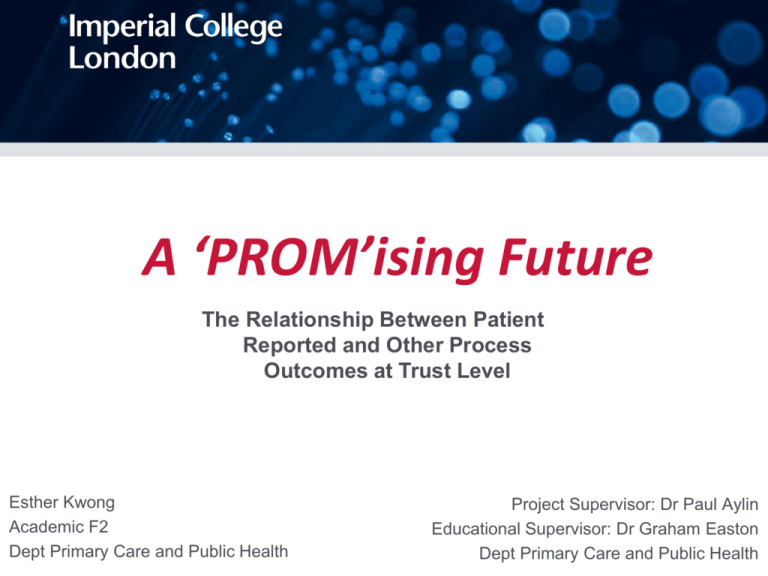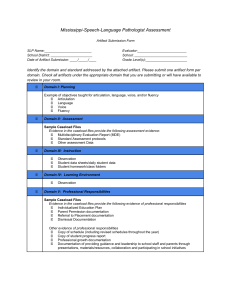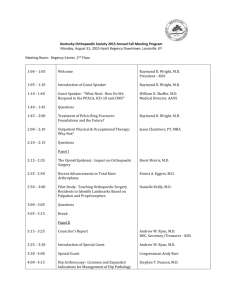PowerPoint - Imperial College London
advertisement

A ‘PROM’ising Future The Relationship Between Patient Reported and Other Process Outcomes at Trust Level Esther Kwong Academic F2 Dept Primary Care and Public Health Project Supervisor: Dr Paul Aylin Educational Supervisor: Dr Graham Easton Dept Primary Care and Public Health Contents The Context –Setting the Scene for PROMs NHS What are Outcomes Measuring Patient Reported Outcomes National PROMs Program Overview Research Question Methods Results Discussion & Conclusions What have I learnt… The Past “Despite a century of developments in medical technology, and vast improvements in the ability of medical science to prevent, diagnose and treat disease and ill health, attempts to measure the outputs of health care in terms of their impact on patients’ health have not progressed beyond Florence Nightingale’s time.” Getting the most out of PROMs Kings Fund 2010 The Context Reasons for Healthcare: Live Longer Better Quality of Life = Better Health Outcome But health services traditionally focused on one outcome Mortality Setting the Scene for PROMS Darzi Review “High Quality for All” NHS White Paper Equity and Excellence: Liberating the NHS Appraisal of new technologies – PRO data incorporated in the evaluation of new technologies Routine measurement of pre/post elective surgery PROMs Since April 2009 DH Long Term Conditions PROMs Pilot Since 2010 Patient Centred If quality is to be at the heart of everything we do, it must be understood from the perspective of patients. Patients pay regard both to clinical outcomes and their experience of the service... Lord Darzi The ultimate measure by which to judge the quality of medical effort is whether it helps patients, as they see it. Donald Berwick What Are Outcomes Traditional Ways of Planning = Measuring in terms of OUTPUT • Quantifying what is produced, implemented, provided, and developed in the health service Increasing Focus = Measuring in terms of OUTCOME • Quantifying extent of any health impact on patients • Change in various dimensions ~physiological (e.g. functional status) or psychological (e.g. attitudes) • Can be harnessed from different sources Sources of Outcomes Measuring Patient Reported Outcomes Patient Reported Outcomes (PRO) • Health status as perceived by the patient Patient Reported Outcomes Measures (PROMs) • Measurement tools to harness this information • Can be used in two points in time to record change in health status • Can be assessed against patient progress or health interventions received • Various types available • Much dedicated research and analysis on validating questionnaire types Types of PROMS EQ5D Oxford Hip Score For any condition Generic Different Disease states Aggregation and comparison Economic evaluations Condition Specific Outperform on sensitivity Centred on a particular aspect/ clinical detail Focused – useful for informing National PROMs Program Overview Since 1 April 2009 Providers required to collect and report PROMs Four key NHS funded elective interventions • Unilateral hip replacements • Unilateral knee replacements • Groin hernia surgery • Varicose vein surgery Expected to invite patients to complete a pre-operative PROMs questionnaire (Q1) Post-operative questionnaires (Q2) are then sent to patients following their operation after a specified time period. theNHS NHSwill willbe bethe thefirst firsthealth healthcare caresystem ……the in system world to measure what itin terms the worldintothe measure what it produces in terms ofinhealth, in ofproduces health, rather than termsrather of the than production of care. the production of health care. ofterms health Getting the most out of PROMs Kings Fund Getting the most out of PROMs Kings Fund PROMs Used for the National Program EQ5D index score • Multi-dimensional – five areas • Responses record three levels of severity • Scores are weighted and combined to give a single index EQ5D Visual Analogue Scale • Self rating health related quality of life • Places self reported health state on a point in a line • Line ranges from 0 to 100 Oxford Hip Score • Validated tool specific for Total Hip Replacements • 12 questions to assess function and pain, 0-4 points • Given as a single summed score from 0 to 48 Oxford Knee Score • Validated tool specific for Total Knee Replacements • 12 questions to assess function and pain, 0-4 points • Given as a single summed score from 0 to 48 Research Topic Aim: To explore the relationship between routinely collected patient reported and other process outcomes at trust level Null Hypothesis: There is no relationship between patient reported and other process outcomes at trust level Methods: Aggregate analysis conducted using STATA 11 on trust level data Participation and Coverage 2010 Participation rate of 69.7%. •245,488 eligible hospital episodes •171,080 pre-operative questionnaires returned Return rate of 75.8% •147, 974 post-operative questionnaires sent out • 112,163 returned National PROMs Key Final Results 09-10 Overview EQ-5D Index score Oxford Hip and Knee Score 87.2% of hip replacement respondents 77.6% of knee replacement respondents 95.7% of hip replacement respondents 91.4% of knee replacement respondents Recorded an increase in general health following operation Recorded an improvement following operation Data Sources Dr Foster Data Hospital Episode Statistics (HES) PROMs data 2010 August 2011 Publication Used Orthopaedic Revision Rates Orthopaedic Readmission Caseload Staff to bed ratio Aggregate Trust HSMR Level Data 2010 National Joint Registry Data Orthopaedic Procedures Caseload HES Inpatient Data Elective Surgery Waiting Times Emergency Admission Caseload Data Comparison Other Process Outcomes/ Hospital Indicators Compared PROMs Outcomes 2010 Data- Hip and Knee Data Case Adjusted Health Gain (Q2-Q1) • • • EQ5D Index EQ5D Visual Analogue Scale Oxford Hip/ Knee Score 1. Hospital Standardised Mortality Ratios 2. Dr Foster Orthopaedic Revision Relative Rate 3. Dr Foster Orthopaedic Readmission Caseload 4. National Joint Registry Data Orthopaedic Procedure Caseload 5. Hospital Episode Statistics Elective Surgery Waiting times 6. Hospital Episode Statistics Emergency Admissions Caseload 7. Hospital Staff to Bed Ratios Descriptive Results Hip EQ5D Index 22,270 127 21 0.395 0.0364 EQ5D VAS 21,653 128 20 7.53 2.23 3.362 Oxford Hip Score 24,682 131 17 19.3 1.28 20.1 Missing Mean Trusts Interquartile Range 0.4215 14 16 18 20 Oxford Hip Score Case Adjusted health gain 22 .25 .3 .35 .4 Case Adjusted EQ5d HG .45 .1 0 0 0 .05 .1 5 Density Density 10 .15 .3 .2 Standard Deviation .2 15 .4 Outcome Case Numbers Number of Trusts (Observations) 0 5 10 EQ5D VAS Case Adjusted health gain 15 HSMR .45 .4 .35 .3 .25 0 500 1000 NJR no. Hip operation procedures 0.0847 -0.0275 0.0777 -0.0225 -0.0143 -0.1431 10 -0.0919 -0.1263 5 0.0308 0.0606 -0.137 0 -0.05 Fitted values 15 Case Adjusted EQ5d HG 1500 0 500 1000 NJR no. Hip operation procedures 0.1939 0.1567 0.1924 0.1881 -0.0295 -0.0645 -0.0402 -0.0801 -0.0437 0.0573 0.0451 0.0334 0.1258 -0.066 18 20 0.2042 Fitted values 22 EQ5D VAS Case Adjusted health gain 1500 16 Nurse to Bed Ratio Staff to bed Ratio OHS 14 Orthopaedic Procedures Caseload EQ5D VAS OHS Case Adjusted Health Gain Revision Relative Risk Readmission Caseload Surgery Wait Times (days) Emergencies Caseload Hip Procedures Caseload EQ5D Index EQ5D VAS Case Adjusted Health Gain Indicator EQ5D Index Case Adjusted Health Gain Correlations Hip 0 500 1000 NJR no. Hip operation procedures Oxford Hip Score Case Adjusted health gain 1500 Fitted values b Coefficient R2 Value Confidence Intervals 0.0398 0.0000276 0.0334 1.31 x 10-5 539 x 10-5 0.0612 0.0015296 0.0275 -7.27 x 10-5 313 x 10-5 Regression Model Hip F Probability EQ5D index Hip Operation Caseload EQ5D VAS Hip Operation Caseload Regression Hip OHS Hip Operation Caseload 0.0460 0.0009363 EQ5D index Orthopaedic Operation Caseload 0.0453 0 .0000138 0.0317 0.0291 x 10-5 2.72 x 10-5 EQ5D VAS Orthopaedic Operation Caseload 0.0640 0.000775 0.027 4.58 x 10-5 159 x 10-5 OHS Orthopaedic Operation Caseload 0.0742 0.000425 0.0245 4.33 x 10-5 90.2 x 10-5 EQ5D VAS Waiting Time 0.0836 0.0378 0.0267 -510 x 10-5 8030 x 10-5 OHS Waiting Time 0.0734 0.0223 0.0281 -210 x 10-5 4670 x 10-5 0.0305 1.69 X 10-5 186 x 10-5 Description Results Knee Outcome Case Numbers Number of Trusts (Observations) 23,318 180 219 0.299 0.0369 0.45 EQ5D VAS 22,591 177 222 1.836 2.105 3.035 Oxford Knee Score 25,413 189 210 14.81 1.43 1.653 Interquartile Range .2 Density .1 0 0 0 .05 .1 5 Density .15 10 .2 .3 EQ5D Index Missing Mean Standard Trusts Deviation .2 .25 .3 .35 EQ5D case adjusted HG .4 .45 -5 0 5 EQ5D VAS Case Adjusted HG 10 10 12 14 16 18 Oxford Knee Score case adjusted HG 20 EQ5D VAS 16 14 12 EQ5D Index 18 20 Indicator OKS 10 OKS Case Adjusted Health Gain Correlations Knee 50 Revision Relative Risk Readmission Caseload Surgery Wait Times (days) Emergencies Caseload Hip Procedures Caseload 0.2176 0.1014 Orthopaedic Procedures Caseload 0.2215 0.0389 Nurse to Bed Ratio -0.2407 -0.1899 Staff to bed Ratio -0.3242 -0.4102 -0.0795 0.1524 0.0124 -0.0408 0.0388 -0.0447 -0.1586 -0.1459 Oxford Knee Score case adjusted HG 200 250 Fitted values 5 -0.0283 0 0.1257 -5 EQ5D VAS Case Adjusted Health Gain 0.2188 9 0.181 9.5 10 10.5 11 HES Emergency Admissions Caseload 11.5 Fitted values .4 .25 -0.3408 .3 .35 0.1693 -0.185 .2 EQ5D Index Case Adjusted Health Gain .45 EQ5D VAS Case Adjusted HG 9 HSMR 150 Foster RR Knee Revision 10 -0.09 100 0.102 0.104 0.0625 9.5 10 10.5 11 HES Emergency Admissions Caseload EQ5D case adjusted HG Fitted values 11.5 Regression Knee Regression model F Probability b Coefficient R2 Value Confidence Intervals EQ5D index Emergency Admissions Caseload 0.0003 -0.0158 0.135 -0.024 -0.007 EQ5D VAS Emergency Admissions Caseload 0.0341 -0.488 0.0372 -0.94 -0.037 OKS Emergency Admissions Caseload 0.0331 -0.350 0.0382 -0.77 -0.033 Discussion – Important Findings 1 Weak positive correlations between Hip and Orthopaedic Procedures Caseload and all Hip PROMs health gain • Suggests the more procedures a trust does the better its quality of hip replacement procedure perceived by patient • This is an expected correlation direction Weak negative correlations between Emergency Admission Caseload and all Knee PROMs health gain • Suggests the more emergency admissions a trust has the worse the patient perceived outcome for a knee replacement procedure • unexpected correlation direction, warrants further exploration into relational factors – such as trust specialisation and quality relationship Discussion -Important Findings 2 Weak Positive Correlation Between EQ5D Visual Analogue Scale and Oxford Hip Score health gain for hip patients and Waiting Times for Elective Surgery • Suggests the longer a patient waits for elective surgery in a trust the more health gain perceived from hip operation • Unexpected correlation direction • Disease progression factors are adjusted for • May be explained by expectation management ‘Patient Satisfaction = Patient Experience - Patient Expectation’ • Longer waiting times may decrease expectation affecting perceived outcome • Lead time difference Discussions Limitations Recruitment Bias • LSHTM Report to Dept of Health on PROMs recorded correlation coefficient of -0.38 between EQ5D score and every 20% increased recruitment, suggesting low recruitment rates can introduce bias • The report recommended a target recruitment rate of 80% Response Bias • Studies suggest non responders were younger in all PROMs, This is particularly evidenced in orthopaedic PROMs Patient Reported Outcome Measures (PROMs) in Elective Surgery Report to the Department of Health, London School of Hygiene and Tropical Medicine Conclusions Weak/ Lack of Correlations suggests Patient Reported Outcomes are capturing an added dimension of quality that traditional process outcome and clinical indicators were not measuring Weak correlations findings at trust level maybe due to aggregation, this could eliminate clinical variation within and between hospital services as well as patient characteristics • Evidence from clinical governance concluded acute hospitals services were ‘A mix of good and bad’ • Analysis of PROMs at clinical level and unadjusted data may provide further explanations and strengthen correlations Lack of evidence/ data available for statistical relationship significance for correlations • Further work building larger aggregate data set on PROMs • Analysis on new PROMs data, or analysis spanning two years of PROMs data What I learnt from this Academic Rotation Nature of Rotation 2 days a week in GP surgery clinical duties 3 days a week dept based research and teaching activities Research Literature search on PROMs Insight in health services research Handling aggregate data Data management Statistical analysis on STATA Seminars and Journal Club Experience of life as an academic! Teaching Formal Teaching courses/ training Clinical Methods teaching 3rd year Imperial Students Problem Base Learning facilitator GP Wealth of clinical experiences Primary care setting exposure Consultation simulation training References Bevan G , Skeller M, 2011 Competition between hospital and clinical quality BMJ 2011; 342:d3589 Berwick D, Hiatt H, Janeway P, Smith R. 1997 An ethical code for everybody in health care BMJ 1997;315:1633 Black N, Browne J, Cairns J. 2006. Health care productivity. British Medical Journal 333: 312–313. Brooks R, Rabin R, de Charro F. 2003. The Measurement and Valuation of Health Status using EQ-5D: A European Perspective. Kluwer: Dordrecht. Browne J, Jamieson L, Lawsey, J, van der Meulen J, Black N, Cairns J, Lamping D, Smith, S, Copley L,Horrockes, J. 2007. Patient Reported Outcome Measures (PROMs) in Elective Surgery. Report to theDepartment of Health. Available from: www.lshtm.ac.uk/hsru/research/PROMs-Report-12-Dec-07.pdf. Burge P, Devlin N, Appleby J, Gallo F, Nason E, Ling T. 2006. Understanding patients’ choices at the point of referral. Technical report TR359-DOH, Cambridge: RAND Europe. Available from: www.rand.org/pubs/technical_reports/TR359/. Darzi L. 2008. High Quality Care for All. NHS Next Stage Review: Final Report, Department of Health, London. Available from: www.dh.gov.uk/en/Publicationsandstatistics/Publications/PublicationsPolicyAndGuidance/ DH_085825. Dawson J, Rogers K, Doll H, Using Patient Reported Outcomes Routinely: An example in context of Shoulder surgery Open Epidemiology Journal 2010, 3,42-52 Department of Health. 2008. Guidance of the Routine Collection of Patient Reported Outcome Measures (PROMs).Department of Health document DH_081179[1].pdf. Devlin N, Appleby J. 2010. Getting the Most Out of PROMs: Putting Health Outcomes at the Heart of NHS Decision Making. Kings Fund/Office of Health Economics: London. Dolan P. 1997. Modelling valuations for EuroQol health states. Medical Care 35(11): 1095–1108.2010). Greenhalgh J, Long A, Flynn Rob, 2004 The use of patient reported outcome measures in routine clinical practice: Lack of theory or lack or impact. Social Science and Medicine 60 (2005) 833-843 EuroQol Foundation. Springer: Rotterdam. Hospital Episode Statistics: Finalised Patient Reported Outcome Measures (PROMs) in England: April 2009 – March 2010 Isis Outcomes Patient Reported Outcome Measures from the University of Oxford, Orthopaedic Pros http://www.isis-innovation.com/outcomes/orthopaedic/ London School of Hygiene and Tropical Medicine Patient Reported Outcomes on Elective Surgery, Report To Department of Health Dec 2007, http://www.lshtm.ac.uk/php/hsrp/research/proms_report_12_dec_07.pdf NHS North West. 2010. Advancing quality. Available from: www.advancingqualitynw.nhs.uk National Council on Ageing and Older People, 1998 health promotion strategy for older people in Ireland. Adding years to life and life to years National Network of Libraries of Medicine Guide 3: Define Measurable Goals, Outputs and Outcomes http://nnlm.gov/outreach/community/goals.html Office of Health Economics. 2008. NHS Outcomes, Performance and Productivity. Report of the Office of Health Economics Commission. OHE: London. Szende A, Oppe M, Devlin N. 2007. EQ-5D Valuation Sets: An Inventory, Comparative Review and Users’ Guide. Acknowledgements I want to thank all those in the department who have contributed their expertise and advice towards this project and towards my educational development • • • • Dr Paul Aylin, Dr Graham Easton, Dr Jenny Lebus, Dr Michael Soljak, Dr Sonia Saxena Dr Fiona Hamilton, Dr Matthew Harris, Dr Eszter Vamos Elizabeth Cecil, Farzan Rahman, Dr Ghasem Yadegarfar






